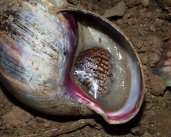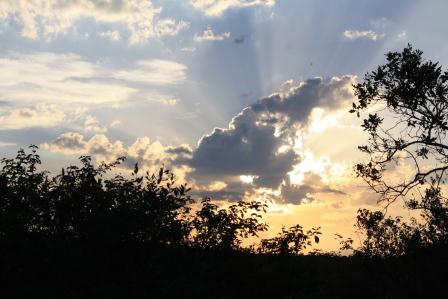Order: Mollusca
Family: Achatinidae
Species:
Achatina immaculata
Achatina transvaalensis
GENERAL INFORMATION ABOUT ACHATINIDAE
The Achatinidae have medium to very large shells, acuminate ovate in shape and often decorated with coloured vertical streaks or flames. About 200 species of Achatinidae occur in Sub-Saharan Africa. The genera include Achatina, Metachatina, Archachatina, Lissachatina and Cochlitoma. More than 30 species are found in South Africa.
The reproductive opening is on the head of Achatinid snails. They are hermaphrodites. Most people then ask if they can fertilize themselves. No. But they do contain male and female reproductive organs and when they mate they can fertilize each other. The sperms develops first in the hermaphroditic gland (the gonad) and a sperm package will be transferred to the other snail where the sperm will be kept in a special sperm pouch in the other snails genital organ. It can be kept for a very long time before fertilization takes place when circumstances are favorable. The egg cells will develop from the same hermaphroditic gland and will then be laid.

The spot behind the eye on the right hand side is the reproductive opening. When you see something white protruding here, it is the ‘penis’
ACHATINIDAE ON OUR PROPERTY
We have two Achatinid species on our farm and both is a rarity to find.
Achatina immaculata – Lamarck, 1822 (Syn. Achatina panthera – Ferussac, 1822)
This variable species has a large, solid shell with a colouration that depends on age. Younger shells (< 80 mm) and most specimens have the typical achatinid flammate patterning of light and dark brown. However, this is lost in most mature specimens. In some specimens the flames become so closely spaced that the shell seems uniformly brown. In addition, many mature specimens have shells that have lost the periostracum due to weathering, and have become a uniform white or cream.

Achatina immaculata

Sun bleached shell
It always has a pink columella which is truncated at the base. The shell varies from obese to slender. The only other local Achatinid with a pink or purple columella is Burtoa nilotica, found in Zimbabwe and Zambia. This species does not have a basal truncation to the columella, is very obese and has a white exterior. The colouration on the columella quickly fades when the animal dies, especially when it is exposed to sunlight.

Pink columella beautifully exposed
The animal has a brownish foot. A darker brown longitudinal stripe runs from between the tentacles back into the shell. On either side of the stripe are two light yellow or brown bands.

The dark longitudinal line is clearly visible in this photo
Many, many yellow pea sized eggs are laid in loose soil and can remain fertile for years until conditions are favourable for the baby snails to survive.

From the front

The part just protruding out of the shell is called the mantle. The mantle is responsible to secrete the shell. This snail just didn’t want to retract fully to expose the pink columella.
The animal will hibernate in winter and aestivate in summer if it is too hot. It will crawl into the soil, retract completely into the shell and excess mucous will be secreted by the mantle. It will harden to form the epiphragm with only a small slither left for oxygen to enter into the respiratory opening called the pneumostome or breathing pore. Yes, these snails have ‘lungs’. A highly vascularized area of tissue inside the mantle cavity functions as a single lung.

Respiratory opening in the mantle.

Respiratory opening closed
Achatina immaculata is a very special and cultural important shell in Africa.
The people who lived in the Iron Age already used A. Immaculata for various purposes.
- Achatina species have been utilized as food, as it still is in certain African communities.
- The shells also deserved a place as tool. The women used the shells to dig clay for their clay pots. A freshwater bivalve species (Spathopsis wahlbergi) was used to burnish the clay pots.
- Beads were made from the shell.
- On the farm Greenswald in the Northern Province at the Mapungubwe archaeological site, A. immaculata, other cultural objects and animal remains have been found buried with human remains. The shells, animals and other objects were probably used as offerings, and that mean that the shells were of big importance to the people. The Mapungubwe people lived about 1100 a.d.
- Later uses that have been recorded are utilization as containers for example snuff, with the aperture (opening) sealed with moss or something similar.
- The big shells also served as a cup, and when the apex was removed; even an infant could drink from it when the mother was unable to nurse the baby. With the open apex the shell is also used to administer medication to the ear.
- Even whole shells were strung, but with a complete different purpose. The rope was fitted to a tree or something similar and rattled to chase away hippos from cultivated fields.
Achatina transvaalensis – Smith, 1878 (Synonym A. subcylindrica, Preston, 1909)

Achatina transvaalensis with periostracum

Achatina transvaalensis without periostracum
This is a medium sized snail and although I often find empty shells, it is a rarity to find a live specimen. And they are camera shy too! Once retracted into the shell, it takes hours before they emerge again. I have kept one in a container for a while, but it didn’t want to eat the ‘artificial’ food like cucumbers that the A. immaculata like so much, and I let it go free to where it belongs. Unfortunately my computer hard disk with those pictures was damaged and I lost my photos of the live specimens. I will update this page when I find a live one again.
It is a fairly small cylindrical Achatina, unicoulored pale buff with 7-8 whorls and sculptured with fine granulation above the periphery.
The foot is very pale, almost yellowish in colour, and it also has a darker longitudinal stripe that runs from between the tentacles back into the shell like most Achatinids.
ACHATINIDS AS PETS
In Europe Achatinid snails are very often kept as pets. I have very successfully kept Achatina immaculata, Achatina smithii, Metachatina kraussii and Achatina vestita as pets. Although they were kept in the same container, they never interbred. I fed them cucumbers, watermelon peels, lettuce and papaja. To supply calcium for optimum shell formation I added cuttlefish bones to their diet. I was very sad when they all died simultaneously after being kept for almost five years. My assumption was that something in their food had traces of pesticides, although I can’t prove that.
It is a very big responsibility to keep snails as pets, as escapees can be introduced in areas where they are not supposed to be and then proliferate. Do a search for Achatina fulica to see how much havoc has been caused in America where they are now classified as alien invader species.
LAND SNAILS IN DERMATOLOGY
If you consider snails as yucky organisms, think twice. The skin cream you are using just might contain snail slime! Products with up to 80% snail slime from the Helix aspersa snail are sold worldwide. In Japan snail slime is taken to the ultimate – you can visit a beauty salon and get an ‘escargot facial’ where live snails will crawl all over your face to benefit directly from their mucous secretions.
FOR MORE INFORMATION
- http://molluscs.at/gastropoda/terrestrial.html?/gastropoda/terrestrial/achatinidae.html
- http://newsfeed.time.com/2013/07/17/snail-slime-facial-coats-skin-in-mollusk-mucus/
- http://www.elicina.co.za/benefits.html
- http://www.worldwidewounds.com/2013/July/Thomas/slug-steve-thomas.html
- Mapungubwe An Archeozoological Interpretation of an Iron Age Community (Voigt, Elizabeth A. 1983) Transvaal Museum
- The Achatinid landsnails of South Africa (M.B Cortie & D. Aiken) – Special Publication no. 7 of the Conchological Society of Southern Africa.
- The Achatinidae of Southern Africa. Mike Cortie. The Strandloper. Issue 247, Sep 1996. Bulletin of the Conchological Society of Southern Africa.
- Update on the Achatinidae of Southern Africa. Mike Cortie. The Strandloper. Issue 250, Sep 1996. Bulletin of the Conchological Society of Southern Africa.










































































